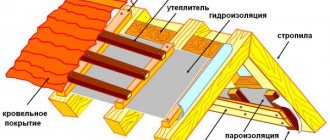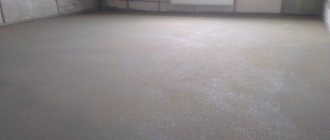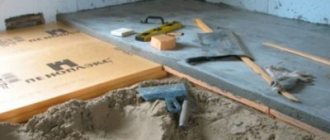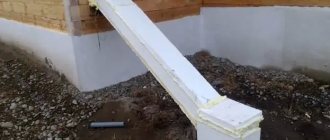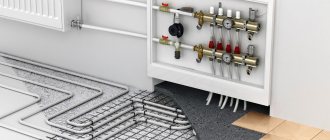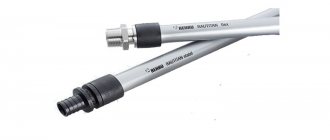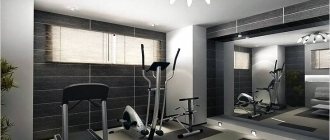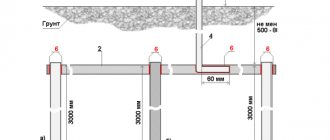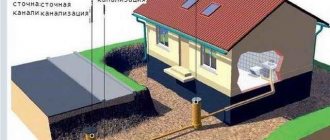Checklist for beginners
It is impossible to decide on the type of waste disposal device until you describe in detail the conditions of its operation that exist on the site. A member of our portal with the nickname sonder RZN has compiled a checklist for those who are choosing and considering a sewerage scheme in a private house. It doesn’t matter whether you do it yourself or with the help of specialists: these questions still need to be answered.
- Determine the type of soil on the site. This can be done at home - just roll the soil into a sausage.
Geolog197FORUMHOUSE Member
If, with a length of 1 cm, the thickness is more than 3 mm, then it falls apart, then it is sandy loam; 1-3 mm is loam, less is clay. If the sausage doesn't roll, it's sand.
It is also necessary to do a test for water absorption: dig a hole 0.5 X 0.5 m, 1 meter deep, pour water into it, note the time and measure the speed at which it leaves. An estimate like “all the water was gone in three hours” is enough. If this is not enough, you can independently calculate the filtration coefficient using a simplified scheme available to every summer resident.
- Determine the level of groundwater and flood waters in the area, understand what the level of high water is.
- Draw up a site plan. It is important that this design indicates neighboring properties and adjacent roads.
- Determine the topography of the site and the topography of the surrounding area. Mark on the plan all ravines, rivers, lakes, ponds. The size of the plot is also important. Without all this, it is impossible to find the best place to install a sewerage system. A filtration field with outlet pipes is a potentially dangerous object; it can be placed no closer than 30 meters from a source of drinking water and no closer than five meters from the foundation of a house.
- Determine the planned volume of wastewater. Often, owners of country premises simply take 200 liters per person per day. You can refer to the document “Water Consumption Standards for Consumers. Water consumption standards. SNiP 2.04.01-85 Internal water supply and sewerage of buildings." When making calculations, you need to take into account how many people live in the house, and when and how many people periodically come to stay - the volume of the volley discharge (short-term entry into the sewer system of wastewater, during which the concentration of pollutants sharply increases) depends on this; Peak load on the sewer system.
The value of a salvo discharge depends on how many plumbing fixtures are in use at the same time. If the volume of wastewater is calculated incorrectly, there is a risk of overflowing treatment facilities.
- Calculate and write down which plumbing fixtures will be in the house on each floor and how many.
- Be sure to take into account where the sewage system is being installed: in a country house or in a house for year-round use.
- A very important factor is the stability of electricity. It’s one thing if it works without interruption or is turned off no more than once every three months for an hour, and another if it’s turned off for half a day every week. This is important for new generation treatment facilities, the design of which includes pumps, sensors, aerators, compressors, etc., which operate from the electrical network.
- Is it possible to service the device yourself?
- To understand whether a sewage truck can drive to the house and to the treatment plant, and to choose its location correctly.
- Consider how far the house is from the city or town.
Septic tank or aeration unit - how to choose
After checking the site according to the checklist, you can begin to select a device that is suitable for a particular site. In the table, they are all conditionally divided into three groups:
- concrete septic tanks;
- plastic septic tanks;
- aeration installations.
Vadim (spb) FORUMHOUSE Moderator
Depends on many things - on the soil, groundwater level, living conditions, availability of electricity, volume of water consumption, budget. Some people prefer a septic tank, others prefer an AU.
Features, disadvantages and advantages of the installations are collected in a table.
Do-it-yourself sewerage in a private house: choosing a device
| Concrete septic tank | Plastic septic tank | AU |
| No electricity required | No electricity required | Electricity required |
| At high groundwater levels, it is difficult to seal. | The body is sealed; anchoring and often reinforcement are required. | Sealed housing, no anchoring required. |
| It copes well with uneven runoff and can be used in “weekend” mode. | It copes well with uneven runoff and can be used in “weekend” mode. | Used for permanent residence, it copes poorly with uneven drainage. |
| Copes perfectly with “volley discharge”. | Copes perfectly with “volley discharge”. | “Valley release” holds only under special conditions. |
| Pumping with a sewer truck should be performed up to 3 times a year. | Pumping with a sewer truck should be performed up to 3 times a year. | It is necessary to pump out the sludge with a mud pump. |
| Does not require special maintenance. | Does not require special maintenance. | Almost all devices of this type require special servicing every six months or every three months. |
| You can do it yourself. | You can do it yourself if you have certain skills and knowledge. | You can’t do it yourself without special equipment. |
| In most cases, this is the most budget option. | Medium budget option. | The most expensive option. |
| Can be connected to filter wells, sand and gravel filters and filter trenches, infiltrators, drainage blocks, drainage tunnels. | Connection to filter wells, sand and gravel filters and filter trenches, infiltrators, drainage blocks, drainage tunnels is allowed. | Can be connected to filter wells, sand and gravel filters and filter trenches, infiltrators, drainage blocks, drainage tunnels and storm ditches. |
If a sewer outlet has already been made from the foundation of the house, you will also have to take into account the depth of the sewer pipe.
This list of devices does not include cesspools, although relatively recently they were a widespread, budget-friendly way to properly arrange sewerage in a private house with a bathroom and toilet. It was believed that if the sewerage system for a country house was made independently, then it was a cesspool, a container for collecting wastewater that flowed through the external sewerage pipeline. These effluents were not treated, but simply pumped out as needed.
This outdated solution is still used today. The walls of the cesspool are lined with brick or concrete; sometimes the cesspool is made without a bottom, and such a structure cannot be called safe.
PavelForumHouse Member
All this is cheap and cheerful until the SES arrives. You can make good money and poison your neighbors. Are your plots expensive? Does it make sense to get rid of neighbors?
A homeowner who has decided on a cesspool needs to know the requirements of SNiP 30-02-97 and SanPiN 42-128-4690-88, according to which:
- You cannot make a hole without a bottom if more than 1 cubic meter is drained into it. If more than two people live in the house and plumbing equipment is installed, a pit without a bottom is also prohibited;
- You cannot make a cesspool closer than 15 meters from the house without approval from Rospotrebnadzor and the Vodokanal Administration.
- The distance of the cesspool from the water supply depends on the material of the pipeline. If the pipes are plastic, then it should be at least 1.5 m; made of cast iron - more than 1.5 m; for asbestos-cement pipes - at least five meters.
- The depth of the cesspool is no more than 3 meters, and the groundwater level must also be taken into account.
If the groundwater level is high, you cannot make a cesspool.
- It is forbidden to fill the container more than 35 cm from the top, this can lead to overflow and contamination of the soil and aquifers!
The cesspool must be cleaned frequently; it is quite expensive and the entire budget comes down to zero.
Now the participants of our portal, if they make sewers with cesspools in private houses with their own hands, it is only in summer cottages and for “clean drainage”: after a shower or a sink for washing dishes. Although it is easy to make such a sewer system for a private house with your own hands, it cannot be considered successful.
Construction of houses
189 votes
+
Vote for!
—
Vote against!
A pressing question that plagues everyone who wants to live in private country houses without the possibility of connecting to a central water supply and sewerage system is how to make an autonomous sewer system. After all, without it it is not possible to fully use such benefits of civilization as a bath, shower, kitchen sink, washing machine and much more. Sewage in a private house can be equipped in different ways, which we will talk about in this article. Choosing the right system that suits your individual conditions and needs is even more important than implementing it.
- What kind of sewerage system can there be - a private house with permanent and temporary residence
- Cesspool without bottom
- Sealed container - storage tank
- Single-chamber septic tank - the simplest option for soil treatment
- Two-chamber septic tank - overflow settling wells
- Septic tank with filtration field - biological and soil treatment
- Septic tank with biofilter - natural treatment station
- Septic tank with forced air supply - artificial treatment station
- Water supply and sewerage of a private house - general rules
- Sewerage in a private house: video - example
What kind of sewerage system can there be - a private house with permanent and temporary residence
The option for arranging a drainage system in private homes is selected depending on several conditions:
- House with permanent or temporary residence.
- How many people permanently live in the house?
- What is the daily water consumption per person in the house (depends on the number of water consumers, such as a bathtub, shower, toilet, sink, washbasin, washing machine, etc.)
- What is the groundwater level?
- What is the size of the site, how much space can be used for treatment systems.
- What is the structure and type of soil on the site.
- Climatic conditions of the area.
You can learn more about the requirements in the relevant sections of SanPin and SNiP.
Conventionally, all sewerage systems in a private house can be divided into only two types:
- Storage systems (cesspool without bottom, sealed container for waste).
- Wastewater treatment facilities (the simplest single-chamber septic tank with soil treatment, a two-chamber septic tank - overflowing wells with natural purification, a two-three-chamber septic tank with a filtration field, a septic tank with a biofilter, a septic tank (aeration tank) with a constant air supply).
Cesspool without bottom
The most ancient method of arranging a sewer system, proven over centuries and even millennia, is a cesspool. Some 50 - 70 years ago there was no alternative to this method. But people did not use as much water in private homes as they do today.
A cesspool is a well without a bottom. The walls of the cesspool can be made of brick, concrete rings, concrete or other material. Soil remains at the bottom. When wastewater from a house enters a pit, more or less clean water seeps into the soil, purifying itself. Fecal matter and other solid organic waste settles to the bottom and accumulates. Over time, the well becomes filled with solid waste, and then it needs to be cleaned.
Previously, the walls of the cesspool were not made waterproof; then, when the hole was filled, they simply buried it and dug a new one in another place.
I would like to immediately note that installing a sewer system in a private house using a cesspool is possible only if the average daily volume of wastewater is less than 1 m3. In this case, soil microorganisms that live in the soil and feed on organic matter have time to process the water that penetrates the soil through the bottom of the pit. If the volume of wastewater is greater than this norm, the water does not undergo sufficient purification, penetrates into the soil and pollutes groundwater. This risks contaminating wells and other water sources within a radius of 50 m. Adding microorganisms to the cesspool somewhat reduces the unpleasant odor emanating from it, and also speeds up the process of water purification. But, nevertheless, it is not worth the risk.
Conclusion . A cesspool without a bottom can be built if the house is visited 2-3 days a week and does not consume a lot of water. In this case, the groundwater level must be at least 1 m below the bottom of the pit, otherwise contamination of the soil and water source cannot be avoided. Despite the lowest cost of arrangement, a cesspool is not popular in modern country houses and cottages.
Sealed container - storage tank
A sealed container is installed on the site near the house, into which wastewater and waste from the entire house flow through pipes. This container can be ready-made, store-bought, and made of plastic, metal or other material. Or it can be assembled independently from concrete rings, the bottom is made of concrete, and the lid is made of metal. The main condition when installing a sewer system in a private house of this type is complete tightness. Pragma corrugated pipes are suitable for sewerage.
When the container is full, it must be cleaned. To do this, a sewer truck is called, the call of which costs from 15 to 30 USD. The frequency of emptying the container, as well as the required volume, depends on the amount of waste. For example, if 4 people permanently live in a house and use a bath, shower, sink, toilet, and washing machine, then the minimum volume of the storage tank should be 8 m3, and it will have to be cleaned every 10 to 13 days.
Conclusion . A sealed cesspool is one of the options for installing sewerage in a private house if the groundwater level in the area is high. This will completely protect the soil and water sources from possible contamination. The disadvantage of such a sewage system is that you will often have to call a sewer truck. To do this, from the very beginning it is necessary to correctly calculate the location of the container to ensure convenient access to it. The bottom of the hole or container should not be deeper than 3 m from the soil surface, otherwise the cleaning hose will not reach the bottom. The lid of the container must be insulated to protect the pipeline from freezing. For such a sewer system in a private house, the cost depends on the material of the container. The cheapest option would be to purchase used Eurocubes, the most expensive would be pouring concrete or brick. In addition there are monthly cleaning costs.
Single-chamber septic tank - the simplest option for soil treatment
A single-chamber septic tank is not far from the cesspool; it is often called that. It is a well, the bottom of which is filled with crushed stone in a layer of at least 30 cm, and on top of coarse sand in the same layer. Wastewater flows through pipes into a well, where the water, seeping through a layer of sand, crushed stone, and then soil, is purified by 50%. Adding sand and crushed stone improves the quality of water purification and partly feces, but does not radically solve the problem.
Conclusion . Conducting sewerage in a private house using a single-chamber septic tank is impossible with permanent residence and large volumes of wastewater. Only for houses with temporary residence and low groundwater levels. After some time, the crushed stone and sand will need to be completely replaced, as they will silt up.
Two-chamber septic tank - overflow settling wells
As one of the economical sewerage options that you can install yourself, the installation of overflow settling wells and filter wells is widely popular.
This sewage system in a private house consists of two wells: one with a sealed bottom, the second without a bottom, but with powder, as in the previous method (crushed stone and sand). Wastewater from the house flows into the first well, where solid organic waste and feces sink to the bottom, fatty waste floats to the surface, and more or less clarified water is formed between them. At a height of approximately 2/3 of the first well, it is connected to the second well by an overflow pipe, located slightly at an angle so that water can flow there freely. Partially clarified water enters the second well, where it percolates through a sprinkle of crushed stone, sand and soil, purifies even more and leaves.
The first well is a settling tank, and the second is a filter well. Over time, a critical mass of feces accumulates in the first well, to remove which it is necessary to call a sewer truck. This will have to be done approximately once every 4 – 6 months. To reduce the unpleasant odor, microorganisms are added to the first well that decompose feces.
Overflow sewer in a private house: photo - example
You can make a two-chamber septic tank yourself from concrete rings, concrete or brick, or you can purchase a ready-made (plastic) one from the manufacturer. In the finished two-chamber septic tank, additional cleaning will also occur using special microorganisms.
Conclusion . It is possible to install a sewer system in a private house from two overflow wells only if the groundwater level, even during a flood, is 1 m lower from the bottom of the second well. Ideal conditions are sandy or sandy loam soil on the site. After 5 years, the crushed stone and sand in the filter well will have to be replaced.
Septic tank with filtration field - biological and soil treatment
We move on to a description of more or less serious cleaning systems that allow you not to worry about environmental pollution.
This type of septic tank is one container divided into 2 - 3 sections or several separate well containers connected by pipes. Most often, having decided to install this type of sewer system, a factory-made septic tank is purchased.
In the first container, wastewater settles, as in the previous method (settling well). Through the pipe, partially clarified water flows into a second container or section, where anaerobic bacteria decompose organic residues. Even more clarified water reaches the filtration fields.
Filtration fields are areas underground where wastewater undergoes soil treatment. Thanks to the large area (about 30 m2), the water is purified by 80%. The ideal case is if the soil is sandy or sandy loam, otherwise you will have to equip an artificial filtration field made of crushed stone and sand. After passing through the filtration fields, the water is collected in pipelines and discharged into drainage ditches or wells. Trees or edible vegetables cannot be planted above the filtration fields; only a flower bed is allowed.
Over time, the fields become silted and need to be cleaned, or rather replaced with crushed stone and sand. You can imagine how much work will have to be done, and what your site will turn into after this.
Conclusion . Laying a sewer system in a private house, which requires the presence of a filtration field, is only possible if the groundwater level is below 2.5 - 3 m. Otherwise, this is a fairly constructive solution, provided there is sufficient free space. Also, do not forget that the distance from the filtration fields to water sources and residential buildings should be more than 30 m.
Septic tank with biofilter - natural treatment station
A deep cleaning station allows for complete installation of sewerage in a private house, even if the groundwater level is very high.
A septic tank is a container divided into 3 – 4 sections. It is better to purchase it from a trusted manufacturer, after consulting with professionals about the required volume and equipment. Of course, the price for such a sewer system in a private house is not the lowest, starting from 1200 USD.
In the first chamber of the septic tank, water settles, in the second, organic matter decomposes by anaerobic microorganisms, the third chamber serves for water separation, since in the fourth, organic matter decomposes with the help of aerobic bacteria, which need a constant flow of air. To do this, a pipe is mounted above the chamber, rising 50 cm above the ground level. Aerobic bacteria are added to a filter installed on the pipe leading from the third section to the fourth. In essence, this is the filtration field - only in miniature and concentrated. Due to the small area of water movement and the high concentration of microorganisms, the water is thoroughly purified up to 90 - 95%. This water can be safely used for technical needs - watering the garden, washing the car and much more. To do this, their fourth section is given a pipe leading either to a container for storing purified water, or to a drainage ditch or well, where it is simply absorbed into the ground.
Sewage treatment in a private house - operation diagram:
Conclusion . A septic tank with a biofilter is a good solution for a private home with permanent residence. Microorganisms can be added to the septic tank by simply pouring them into the toilet. There are no restrictions on the use of such a treatment plant. An undeniable advantage is that it does not require electricity. The only drawback is that sewerage installation in a private house requires permanent residence, since without the constant flow of wastewater, bacteria die. When new strains are introduced, they begin active activity only after two weeks.
Septic tank with forced air supply - artificial treatment station
An accelerated treatment station where natural processes occur artificially. Construction of a sewer system in a private house using an aeration tank will require supplying electricity to the septic tank to connect an air pump and air distributor.
Such a septic tank consists of three chambers or separate containers connected to each other. Water enters the first chamber through sewer pipes, where it settles and solid waste precipitates. Partially clarified water from the first chamber is pumped into the second.
The second chamber is actually an aeration tank; here water is mixed with activated sludge, which consists of microorganisms and plants. All microorganisms and bacteria in activated sludge are aerobic. It is for their full functioning that forced aeration is needed.
Water mixed with sludge enters the third chamber - a settling tank for deeper cleaning. The sludge is then pumped back into the aeration tank using a special pump.
Forced air supply provides fairly rapid treatment of wastewater, which can then be used for technical needs.
Conclusion . An aeration tank is an expensive but necessary pleasure in some cases. The price starts from 3700 USD. There are no restrictions on the installation of such sewerage. Disadvantages are the need for electricity and permanent residence, otherwise the activated sludge bacteria die.
Water supply and sewerage of a private house - general rules
The location of sewerage facilities is subject to certain restrictions.
The septic tank should be located:
- no closer than 5 m from a residential building;
- no closer than 20 - 50 m from the water source (well, borehole, reservoir);
- no closer than 10 m from the garden.
The residential building must be located at a distance:
- 8 m from filter wells;
- 25 m from filter fields;
- 50 m from aeration treatment plants;
- 300 m from drainage wells or stations.
The pipes leading to the septic tank must be insulated so that they do not freeze in winter. To do this, they are wrapped with heat-insulating material and inserted into asbestos-cement pipes. External sewerage installation in a private house is carried out with pipes with a diameter of 100 - 110 mm, the slope should be 2 cm by 2 m, i.e. 2°, in practice they do a little more – 5 – 7° (with a margin). But you shouldn’t joke with this matter, since a larger slope will lead to water quickly passing through the pipes, and feces will linger and clog them, and a smaller slope will not ensure the movement of wastewater through the pipes at all. It is advisable to lay the pipes so that there are no turns or corners. For internal wiring of sewer pipes, a diameter of 50 mm is sufficient. If the house has more than one floor, and baths, sinks, and a toilet are also installed on the upper floors, then a riser with a diameter of 200 mm is used to drain wastewater down.
If you decide that you can do the sewerage of a private house with your own hands, be sure to take into account all the restrictions of SanPin and SNiP regarding the location and design of the sewerage system. In order not to spoil relations with your neighbors, consider the location of their water sources and other buildings.
The sewerage project for a private house is extremely important; you should not try to do without it. Sewerage is not a system that tolerates approximateness. Contact design bureaus or architects, and let the professionals create a working design for you, taking into account all the characteristics of the soil, site, climate and operating conditions. It is better if this project is completed together with the project of the house itself before its construction begins. This will make installation much easier.
If you are interested in the question of how to make a sewer system in a private house with a high groundwater level , then based on all of the above, these could be the following options:
- Sealed container for waste accumulation.
- Septic tank with biofilter.
- Aeration treatment station (aeration tank).
The actual work of installing a sewer system in a private house is not that difficult. It is necessary to install pipes throughout the house that will collect wastewater from different sources, connect them into a collector and run them through the foundation or under it along the ground to the septic tank. You can do the excavation work yourself, or you can hire an excavator. But choosing the right sewerage system and drawing up a project is much more important.
Sewerage in a private house: video - example
Criteria for selecting a filter device
Now you can proceed to choosing a filter device. Without this, it is impossible to properly install a sewer system for a private home.
For modern domestic installations, in most cases the following are used:
FC (filtration well). It is done only on sand and sandy loam - soils that absorb moisture well - SNiP 2.04.03-85 “Sewerage” insists on this. External networks and structures.” The amount of wastewater should not be more than a cubic meter per knock, and the base of the well must be placed at a distance of at least a meter from the water main water supply.
Sand and gravel filters and filter trenches. Suitable if the amount of wastewater is no more than 15 cubic meters per day, they are made in waterproof and low-filtration soils (rock, clay and loam. The highest level of groundwater level is a meter below the drainage tray.
Infiltrators, drainage blocks, drainage tunnels can be made in any type of soil, and the blocks can be connected to each other.
Independent sewerage device
For the internal system you need:
- pipeline
- riser and drain pipe
- audits
- locking elements
- outlet (connection to external system).
the optimal location for the riser
The first step is to route the pipes from each device to the riser. The diameter of the pipe at the bathtub, shower, sinks and sinks is 50 mm, at the toilet - 100 mm. All plumbing fixtures have elbows installed to prevent unpleasant “odors” from the sewer from entering the premises. When installing and fastening the pipeline, it is necessary to take into account the slope (approximately 3 mm per meter). The riser is installed above the ridge and covered with a grill. The opening for the outlet to the external pipeline should not be smaller than 30x30 cm.
The external part of the sewer consists of:
- pipeline
- wells
- storage tank or septic tank.
It is best to install a pipeline located above the freezing level from cast iron. The use of plastic materials is allowed when buried below the freezing level. In a system without a pump, the pipeline is laid with a slope
It is important that the septic tank or septic tank is located no closer than 5 m from a residential building and 20 m (at least) from a well with drinking water. In addition, it is necessary to ensure free access for vacuum trucks.
The pipeline is installed and laid.
The size of the septic tank pit should be larger than the container (so that a concrete pad can be created at the bottom). In this case, the neck of the container at the end of the work should be located slightly above the ground level. The spaces between the septic tank and the walls of the pit are filled with a cement-sand mixture and compacted. After connecting the pipes to the septic tank and checking for tightness and functionality, all trenches are backfilled.
It is more convenient to install a system for collecting melt and storm water separately. This will avoid increasing the volume of the septic tank. In addition, melt and rain water is much cleaner than domestic wastewater, so it can be used for technical needs (for example, irrigation).
First you need to mark the surface and dig trenches for outlets and pipes (taking into account the slope), as well as holes for storm water inlets. The trenches for the outlets are concreted, and a 10 cm thick sand cushion is placed at the bottom of the trenches for the pipes. Catchment basins must be equipped with funnels that are covered with nets. All elements of the stormwater system are connected.
The cost of connecting the sewerage system of a private house to the general network depends on the cost of completing all the necessary documents, the volume of materials and their type, and the cost of the installation contractor. Depending on the region, the total amount varies between 50-150 thousand rubles. The cost of an autonomous system can range from 500 thousand to 1.5 million rubles. To save money, you can build one system for several houses.
https://youtube.com/watch?v=4IbYUyWsWV8
Which septic tank is suitable for the site: plastic or reinforced concrete
A modern sewer system in a private house will look correct if it is based on a septic tank. This option is chosen by the vast majority of homeowners.
In septic tanks, mechanical wastewater treatment occurs due to sedimentation, and only then due to the fact that bacteria living in the septic tank destroy organic matter in the absence of air. After settling and mechanically purified in septic tanks, the wastewater is sent either to filter devices.
LadomirModerator FORUMHOUSE
It is forbidden to pour effluent from a septic tank into a ditch; it is punishable and unhygienic.
The septic tank must have a bottom and be sealed. The construction of septic tanks is regulated by the standard for organizing autonomous sewage systems with septic tanks and soil underground filtration of wastewater - STO NOSTROY 2.17.176-2015. This document provides for the following distances of the septic tank from other objects on the site:
- to the house – 5 meters;
- to a well or borehole in areas with clayey soil or loam - 20 meters in areas with clayey soil;
- to a well or borehole in areas with loam, sandy loam or sand - 50-80 meters;
- to the side of the road – 5 meters;
- to the border of the site - 4 meters;
- to trees - 3 meters;
- to the bush - 1 meter;
- to a river or stream – 10 meters;
- to a pond or lake – 30 meters;
- to the underground gas main - 5 meters.
In the table, all septic tanks are divided into plastic and septic tanks made of concrete rings. For do-it-yourself sewerage in a private house, septic tanks made of reinforced concrete rings . They are the most budget-friendly, they are durable, almost eternal, can withstand heavy loads under soil pressure and are easy to install yourself. But such septic tanks are unacceptable when there is high water and high groundwater level.
Plastic septic tanks can also be installed in areas with high groundwater levels; they are lightweight, but many plastic structures are fragile, can be deformed during frost heaving of the soil and require anchoring. When buying a plastic septic tank, it is recommended to look at the internal partitions and stiffeners along the body - the more of them, the higher the rigidity of the product. Horizontal plastic septic tanks clean wastewater better, but vertical ones are more compact.
Like a cesspool, a septic tank must be periodically cleaned with a sewer truck, but if you choose the right volume, this will have to be done no more than once a year.
Calculating the volume of a septic tank is quite simple: it should be three times the daily volume of drainage. This also follows from the main book of all home engineers, “Engineering Systems of a Country House,” authored by V. Sinelnikov.
The constantly filled part of the well (hydraulic volume) should be equal to three times the daily inflow.
Vadim (spb) FORUMHOUSE Moderator
3 cubes is enough for 4 people. And it doesn’t matter, in my opinion, how the filtering is organized. The volume of the septic tank does not depend on it.
LadomirModerator FORUMHOUSE
According to the Standard, the volume of the septic tank must be at least 2.4 cubic meters, even if 0.5 people live irregularly.
Types of sewerage with septic tank
A septic tank is a container consisting of one, two or three chambers connected by overflow pipes. From the last chamber, purified water enters the filtration field, the absorption well, and the filter trench. The choice of a specific type of final filtration depends on the type of soil and groundwater level.
With filter well
When groundwater is low and soils drain water well, a filtration well is made. Usually these are several reinforced concrete rings without a bottom.
Sewage system for a dacha with a septic tank and filtration well
With filter field
When the groundwater level is up to 1.5 meters and/or when the drainage capacity of the soil is poor, wastewater is discharged to filtration fields. These are quite large areas in which part of the natural soil has been replaced with sand and crushed stone. Water from the septic tank enters this field through perforated pipes, where, passing through the layers, it is further purified, and then goes into the underlying layers of soil.
Example of a filtration field for a summer residence
The structure of this field is layered - sand at the bottom, then crushed stone in which drainage pipes are laid. Decorative plantings can be planted on top. The location of this treatment plant is as far as possible from the garden and fruit trees. The disadvantage of this system is that after a while the crushed stone silts up and the water stops flowing. It is necessary to open and replace the filtrate (sand with crushed stone).
Structure of the filter field for country sewerage
Into the gutter
If there is a drainage ditch near the septic tank, you can drain the water into it for further purification. To do this, a small pit is dug in front of the ditch, which is covered with crushed stone. The water is discharged into the crushed stone, from where it enters the ditch.
Output to the gutter
This option is possible if the degree of wastewater treatment is high. Typically, such a scheme is offered when installing VOC or AC. But to be sure, it is advisable to have on hand the result of a chemical examination confirming the degree of purification. This document may be needed if neighbors complain and an inspection comes.
You can read about the autonomous sewage system Topas here, and about the individual wastewater treatment plants of Tver here.
How many chambers are there in a septic tank?
In SNiP 2.04.03-85, the number of chambers in a septic tank is tied to the daily water flow:
- up to 1 cubic meter/day - one chamber;
- from 1 to 10 cubic meters/day - two chambers;
- over 10 cubic meters/day - three.
In this case, the volume of the septic tank must be at least 3 times the daily flow. One camera is rarely made, as well as three. One does not provide the required degree of purification, and three are too expensive.
Aeration plant in a suburban area
The sewerage system in a private house with an aeration plant (the term VOC is also used, local treatment plant) is considered the most modern for wastewater disposal, the quality of treatment reaches 90%.
These installations in the sewerage system are complex and cannot be done with your own hands. They are based on devices made of fiberglass or propylene, but due to their design with stiffening ribs and many protruding elements, they are not deformed and are not squeezed out to the surface by heaving soils.
ACs operate on a different principle than septic tanks. If in septic tanks wastewater is first mechanically purified during settling, and organic matter is partially decomposed during anaerobic processes, then in AC the main purification occurs during the oxidation of organic molecules with oxygen. In such a sewerage system in a private house, bacteria work, which require oxygen to live (in sewerage systems with septic tanks, this process takes place in filtration wells, filtration fields, etc.).
There are two types of AC – with a compressor or a drain pump. In an AC with a compressor, wastewater, after settling in the first chamber, enters the second, and there it is saturated with oxygen. What happens is that the microflora in the wastewater multiplies wildly and forms activated sludge, which destroys all organic compounds. The water becomes clearer, but now it contains silt particles. All this goes into the third chamber, the sludge settles and is sent back to the aerochamber, and the purified water is removed outside the installation.
In an AC with a drainage pump there are also several chambers, and wastewater moves between them by gravity. The treated wastewater is pumped to the sprayer, then passes through the biofilter, cleaned and discharged outside.
For stable operation of aeration units, electricity is required, and even a shutdown for several hours is fraught with the death of aerobic bacteria. The second disadvantage of AU is its blatant lack of budget; any septic tank always costs less.
The AC on the site should be located below the well or borehole, but so that in the spring it will not be flooded with melt water. Like septic tanks, VOCs are installed in a pit with a sand lining at the bottom.
Many manufacturers allow water to be discharged from the AC directly onto the terrain, into a ravine, forest, or storm drain. This is still a controversial issue, and many are inclined to believe that this should not be done, or only after additional and expensive disinfection; but it is recommended to install AU in areas with clayey and heaving soil, high groundwater level and where there is no possibility of making a filtration well, filtration field and other filtration installations.
How does a filtration well work?
A filtration well is the simplest and most compact of all filter structures that you can build yourself. Almost all owners of private houses would prefer a filtration well when installing a sewer system, but their installation is limited by a number of conditions:
- — moderate volume of wastewater (less than 1 cubic meter per day);
- — good filtering ability of the soil (For stable operation of the system, sand and sandy loam are needed; even black soil and loam are suitable, but with a predominance of sand). But the lighter the soil, the slower the well will silt up!
- — low groundwater level (below 3.5 m).
The FC can be made from available materials, from tires and bricks to large-diameter concrete rings, the main thing is that holes with a diameter of up to 50 mm are evenly made in the walls of the well. The total area of the holes is 10% of the total area of the well walls.
Unlike a septic tank, which must have a bottom, the FC does not have a bottom; it is placed on a gravel-crushed stone base with a height of at least 30 centimeters. The lower part of the well is covered with coarse river sand and gravel, and the height of the filter depends on the soil: if there is sand, then 25-30 cm, and if there is loam, then up to a meter. The size of the backfill fraction also depends on this: from 40 mm on sandy soils to 3-10 mm in loams.
The FC is buried to a depth of 2.5 - 3 meters, and the outside is also covered with a layer of gravel and crushed stone, the width of the layer is 30 cm, the height is up to the pipe that comes out of the septic tank. The outer backfill is covered with a geomembrane and covered with earth. The well must be covered with a lid with a built-in hatch.
.How this system works: the septic tank retains and partially dissolves “undissolved contaminants” from the toilet, feces, etc., and passes the rest into the filtration well. The liquid in the well slowly passes through the filter base and is absorbed into the soil; the organic matter that it contained is dissolved and processed by bacteria, “dying peacefully in a few weeks.”
AlexeyL Member of FORUMHOUSE
In addition to the septic tank itself, a “soil filter” is required, a structure that will take the clarified runoff below the freezing depth of the soil and distribute it over an area sufficient for absorption into the soil. Sometimes it is made in the form of 1-2 rings with a lid; The cross-sectional area of the ring works, but not on all soils this is enough for water to escape into the soil. It is advisable to do a soil absorption test before construction.
LadomirModerator FORUMHOUSE
The main thing is that the soil around the well is capable of receiving the amount of runoff you need.
The foundation pit is dug manually, and in order not to harm the filtering capacity of the future well, it is not raining and “trampling” on the bottom of the pit. If necessary, several filtration wells are installed in the autonomous sewage system.
How to choose an autonomous sewer system for a private house
CHOOSE A SEPTIC FOR YOUR HOME
In private houses, in the absence of a centralized sewerage system, the solution is to arrange an autonomous drainage system. There are various types of septic tanks on the market; they differ in operating principle, price and durability.
The selection of a septic tank must begin with the definition:
- The purpose of the house is for permanent or temporary residence. There are models of cleaning equipment for which prolonged downtime is contraindicated. For dachas, a cesspool would be better suited.
- Area of the site, soil composition and water course. It is not possible to install a filtration field in small areas. If aquifers lie close to the surface, a filtration well will not be suitable.
- Number of discharges per day - this indicator is calculated depending on the number of people living in the house. It is stated in the instructions for the device.
The productivity of the equipment should be equal to three times the size of wastewater per day, since the cleaning process takes 3 days. According to standard standards, there are 200 liters of drainage per person. If three people live in a house, then the storage capacity is:
200 l x 3 people x 3 days = 1800 l or 1.8 m³
- Depths of drainage pipes. For most models, the pipes cut 800 mm below the ground surface. And since the installation is carried out with a slope, the fan pipe must be no lower than 700 mm.
- System material. The installation process, operation and maintenance of an autonomous sewer system depend on its properties and quality.
- Your financial capabilities. Buying high-tech models and maintaining them will be expensive. You can reduce costs by installing one or two-chamber septic tanks.
If you are not sure about the correct choice of model, then contact knowledgeable people. The main thing to remember is that the equipment should last for more than one year.
Filtering fields: application features
The filtration field is a more complex engineering structure than the FC, which cannot be called compact, but it can also be used in areas with high groundwater level and a large volume of wastewater, more than a cubic meter per day. True, not every soil is suitable here; nevertheless, it must filter well. Most often, filtration fields are made in loamy soil.
The filtration field is a system of perforated pipes with a diameter of 110 mm (you can take ordinary plastic sewer pipes and make cuts in them) at a depth of at least half a meter with a slight slope.
How to create a proper filter field:
- make a cushion of crushed stone and gravel with a height of 0.2 m;
- lay pipes;
- cover again with crushed stone and gravel, the height of the layer is 10 cm above the top of the pipes;
- cover with a geomembrane;
- cover with soil.
To correctly calculate the number and length of pipes in such a sewerage scheme for a private house, you need to take into account two parameters: the volume of wastewater and the filtering properties of the soil. Pipes can be positioned in different ways, but the more branched and longer the pipeline, the better the cleaning will be.
There is a simple table that allows you to make an approximate calculation of the filtering field. It is easy to use: the top line shows the volume of the septic tank, and the type of soil in the left column. If the type of soil on the site is sandy loam, the volume of the septic tank is 5 cubic meters, then at least 5 meters of pipes are needed.
For constructing a filtration field for a household septic tank, such a table is quite sufficient.
The downside of the filtration field is that it always “bites off” a significant piece of the area, at least 30 square meters. And the biggest advantage of using this system, besides the high quality of cleaning, is durability; the filtration field silts up after approximately 10 years of service.
Popular septic tank models and their costs
CHOOSE A SEPTIC FOR YOUR HOME
The rating of popular autonomous sewerage models is as follows:
- Aquatek VOC - provides biological decomposition of wastewater in a house with 5 residents, the purification level is 98%. The price starts from 115 tr.
- "Tver" is a system for a private home. It costs from 90 thousand rubles, but the price is justified, since the device provides deep cleaning.
- “Topas” is modern equipment with a high level of waste liquid purification. The construction process is quick and easy, despite the structural complexity. Cost from 70 tr.
- Eurolos Eco is a compact device recommended for medium-sized houses. Processing waste using biological methods. The price starts from 52 tr.
- "Triton" is an uncomplicated, convenient and inexpensive model. But it is suitable for houses with two residents, no more, otherwise frequent pumping will be required, and this will be expensive. Cost from 16 tr.
- “Tank” is a reliable design, the kit includes an infiltrator. The cost without an infiltrator (it must be purchased separately) is about 18 thousand rubles.
- “Termite” – no manufacturer’s warranty, inexpensive. Suitable for arrangement in summer cottages.
Infiltrators and drainage tunnels
In small areas, the installation of filtration fields is impossible, and the optimal solution here may be the use of ready-made infiltration or drainage tunnels.
They are installed one or two meters from the septic tank, and one such device with a volume of 300 liters replaces about 36 meters of drainage pipes and 800 kg of crushed stone. Externally, the ecnhjqcndj looks like a large container without a bottom; in some models the walls are perforated, in others they are solid (but then a perforated drainage pipe is built into the design).
Miket78FORUMHOUSE Member
Infiltrators form a cavity located underground into which water flows after the septic tank. The water goes into the ground - the cavity is freed. To ensure the required performance, it is not the number of septic tanks that is important, but the absorbency of the soil.
Individual modules of drainage tunnels can be easily assembled with each other into a structure of the required volume. They are installed in the same way as filtration fields, deepened at least half a meter from the surface of the earth, but covered on all sides and on top with a layer of sand or soil at least 50 cm thick.
Pipeline and ventilation for autonomous sewerage
The requirements for the pipeline are approximately the same for all treatment facilities for autonomous sewage systems in a country house. When installing sewers, it is better to avoid right angles (every turn is a potential blockage), and it is better to choose synthetic materials: they are resistant to corrosion and do not accumulate deposits inside, like metal pipes. In regions with a temperate climate, sewer pipelines are usually not insulated - the temperature of wastewater is usually +15 degrees or higher, and besides, it quickly passes through the pipes, and there is nothing to freeze in them. Pipe laying is possible even above the ground freezing level. In cold regions, they are insulated with foam plastic or other similar thermal insulation material.
High-quality sewerage installation in a private house largely depends on whether it was possible to correctly remove the pipe from the house and maintain a slope of 1.5 cm per meter so that the waste flows to the septic tank, water treatment plant or cesspool by gravity. But no more, otherwise the liquid will leave, and the solid fraction will linger in the pipes. In trenches for sewer pipes, you need to make a sand cushion up to 15 cm high, the sand must be spilled and compacted. The laid pipes also need to be covered with sand and compacted, only then the whole thing is covered with soil.
Regardless of the choice of filtration structure, a ventilation riser (or several) is installed in the autonomous sewer system. Ventilation is necessary for:
- removing toxic gases and unpleasant odors from the septic tank;
- in order to avoid water seals in the sewer system.
Ventilation risers can be made from ordinary gray pipes used for sewage, the main thing is to cover them with lids so that debris does not get inside. The sewer riser should be approximately 70 cm above ground level. An example is in the photo.
Stages of sewerage installation in a private house
If you would like to independently install a sewer system in a private house by connecting to the central system, then you should take the following steps:
- it is necessary to use the services of a surveyor to draw up a situational plan of your site, including a plan of the house itself and marking the path along which the sewer line will be laid;
- submit an application to the relevant organization for the development of technical conditions for wastewater disposal on your site;
- These technical specifications must be transferred to design specialists who will develop a project for entry into the central sewerage system. The finished project must be submitted to the architect and the water utility service for approval;
- the architect must issue permission for the work to be carried out by a specific organization;
- it is also necessary to obtain the consent of your neighbors to carry out work near their homes to connect to the central sewerage system;
- if the work involves destruction of the road surface (if the highway passes through it), then it is necessary to obtain the appropriate permits from the traffic police, as well as from the road maintenance service;
- before putting the line into operation, it is necessary to notify the water utility service;
- upon completion of the sewerage installation work, the operating organization must accept the finished project and sign an agreement with you regulating the acceptance of wastewater from you.
When laying sewer pipes, it should be remembered that the pipe should lie at a depth of 1200 mm from the house, and the slope should be approximately 5 mm per linear meter.
Storm sewer - connection to the city storm network
Many owners of private cottages would like to drain rainwater from their plots together with domestic wastewater. Technically, this is not at all difficult, but directing rainwater into sewer wells is strictly prohibited.
This method can easily lead to the well overflowing, causing a large amount of sewage to come out. Therefore, to free the area from accumulated rainwater, it is necessary not only to install a sewer system in a private house, but also to connect it to a central or city storm sewer. Since storm sewerage has a much greater capacity, rainwater flows will not create excessive load on it. The rainwater pipe can lead directly to the collector.
Keep in mind that during heavy rainfall, water can flow back through the drain pipe, so when connecting to the central storm sewer system, it is necessary to install a return valve.
Installation of an autonomous storm sewer in a private house
The most practical way is to install a special pit on the site with a reservoir for draining rainwater. A similar system can also be used as a local sewage system for a summer residence. The reservoir is located in the soil, and therefore natural cooling occurs, preventing the growth of bacteria. Then a drain is laid through which rainwater from the roof of the house will flow into the reservoir. It is also advisable to install a special grill that will act as a filter and keep leaves, branches and other debris out of the tank.
The water accumulated in the tank can then be used, for example, for irrigation.

